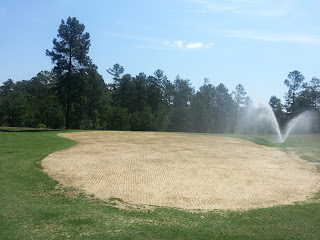The project to renovate the chipping green is progressing but is about a week behind schedule. There are several reasons for the delay, but the most prominent reason is weather. First we had tropical storm Andrea dump seven inches of rain on the property. Six days later we had a huge straight line wind storm known as a "derecho" move across North Carolina and cause major tree damage. I have experienced floods, hurricanes, and tornadoes but that was my first "derecho". Friday morning half of Moore County was without electricity from storm damage. Wind damage was extensive with over twenty major trees coming down. Some fell with their roots looking like a pancake and many others snapped off somewhere in their trunk. Two woodpecker cavity trees suffered the fate of snapping. All golf course resources, both personnel and equipment were dedicated to the cleanup. It was a mess with broken branches, leaves and pine cones everywhere. We lost several days of work to a tropical storm and several days to a derecho. We are still cleaning up the golf course perimeters.
Finally last week we were able to resume shaping the new green and irrigation will be installed on the new chipping green today. We will be visited by Blake Bickford of Fazio Golf Design on Tuesday for architectural approval. We are scheduled for installation of "Celebration" Bermuda grass sod around the green on Wednesday. We will sprig "Miniverde" ultradwarf Bermuda to the green surface on Thursday or Friday. The new green should be about 5500 square feet. We will have continuous Bermuda grass from the putting green to the chipping green. Going forward there will be suitable space for more than one person to practice in that area safely.
This chipping green is being built as a California style green rather than as a USGA style green. This decision was made with input from the golf course architect as well as the turf grass professionals who sell and install the ultradwarf Bermuda grasses. The style of construction will not affect the way the green plays but does affect the cost and difficulty of construction. We were careful to make sure that the growing medium for the new green was a uniform silty sand. We removed the old internal drainage and mixed the sublayer of drainage into the old greens mix and capped it with our silty sand. We feel that this method will create a very good soil profile for growing Bermuda grass. The perched water table of a USGA style green is important for growing bentgrass but not so much for bermuda grass.
Our Champion bermuda grass green which was planted two weeks ago is progressing nicely. The sprigs have developed their own root system and stolons are just beginning to run outward from the lines where the sprigs were cut into the sand. The lines you see are typical of a bermuda grass grow in. The areas between the lines will fill in over the next few weeks.
Unfortunately, we are seeing more damage in the bermuda grass during transition this year than we had hoped for. The picture above is an extreme example. We are seeing regrowth from the interior of most areas and have applied fertilizer to the entire golf course to promote growth. Areas which do not recover over the next several weeks will be sodded. It was a very late spring and the ryegrass lasted longer than normal. Until we killed the ryegrass the bermuda could not recover.





